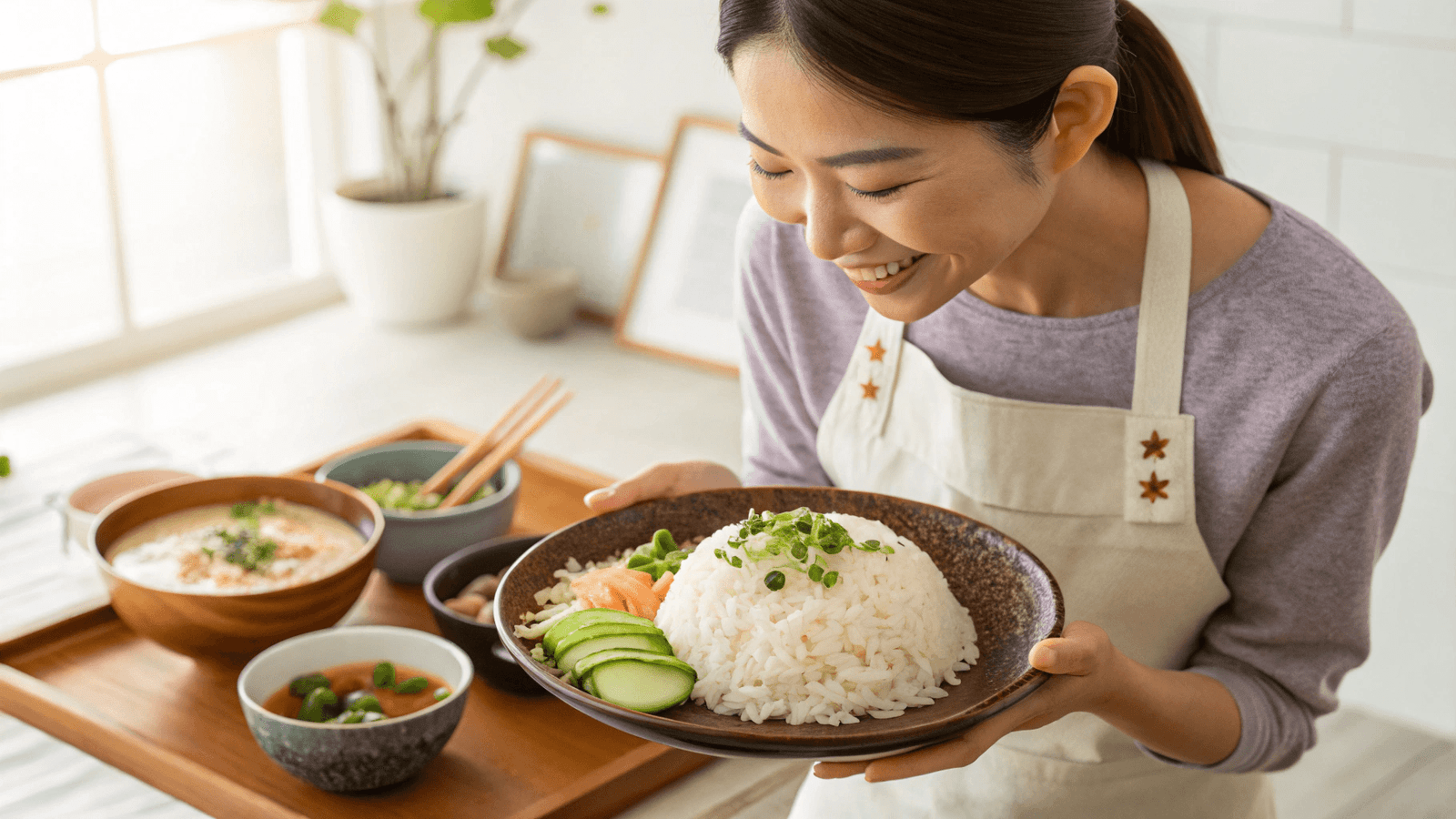Steamed Rice Perfection: 7 Expert Tips for Fluffy, Delicious Results Every Time
Introductory Description: Learn 7 expert tips for perfect steamed rice every time! Get fluffy, delicious results with our comprehensive guide.
Table of Contents
Steamed rice. It’s a humble food, found in almost every culture. However, getting it just right can be tough. Mushy, sticky, or burnt rice is a common kitchen problem. Therefore, we’re here to help! In this guide, you’ll discover 7 expert tips for steamed rice perfection. These tips will help you achieve fluffy, delicious results every time. So, get ready to transform your rice cooking skills!
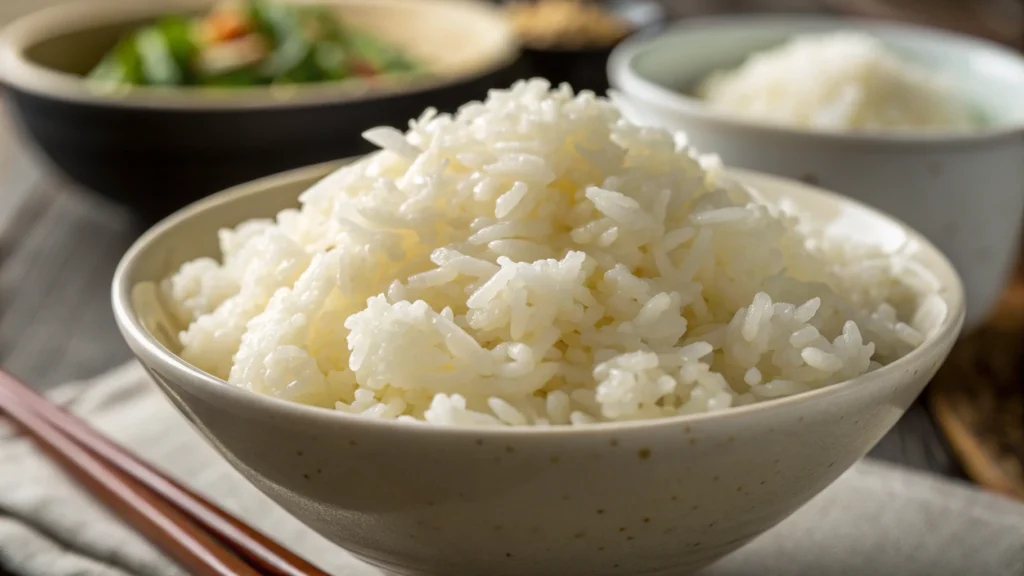
II. Understanding Rice Varieties: The Foundation of Success
The first step to steamed rice perfection is understanding the different types of rice. Just like different flours are used for different baked goods, different rice varieties are suited to different dishes. For example, short-grain rice is great for sushi, while long-grain rice is ideal for pilafs. In addition, knowing the characteristics of each type will help you choose the right one for your needs and adjust your cooking method accordingly.
A. Short-Grain Rice (Sushi Rice)
Short-grain rice, often called sushi rice, has a high starch content. Therefore, it becomes sticky when cooked. Its unique stickiness makes it perfect for sushi, rice balls, and sweet desserts. However, it requires less water than other types of rice. In addition, a specific washing technique is important.
B. Medium-Grain Rice (Calrose)
Medium-grain rice, like Calrose, is a versatile option. It has a good balance of starch. Consequently, it’s slightly sticky and suitable for many dishes. For example, you can use it in everyday meals, casseroles, or paella. In addition, it’s a great all-purpose choice.
C. Long-Grain Rice (Basmati, Jasmine)
Long-grain rice, such as Basmati and Jasmine, has distinct grains. Therefore, it cooks up fluffy and separate. Moreover, these varieties are often aromatic. For example, Basmati is known for its nutty scent, while Jasmine has a floral aroma. They are ideal for pilafs, curries, and side dishes. Also, soaking before cooking can improve their texture.
D. Brown Rice
Brown rice is a whole grain. Therefore, it’s chewier and more nutritious than white rice. In addition, it has a nutty flavor. Brown rice is excellent as a healthy side dish, in bowls, or in salads. However, it requires a longer cooking time and more water compared to white rice.
E. Wild Rice (Technically a Seed)
Wild rice is not actually rice. However, it’s a type of grain. In fact, it’s the seed of an aquatic grass. Wild rice has an earthy flavor and a chewy texture. It’s nutritious and adds a unique element to dishes. For instance, it can be used in pilafs, soups, and salads. Wild rice requires a significantly longer cooking time.
F. Parboiled Rice (Converted Rice)
Parboiled rice, also known as converted rice, undergoes a special process. This process drives nutrients into the grain. Therefore, it becomes less sticky. It’s a forgiving option for inexperienced cooks. Parboiled rice is useful in general rice dishes.
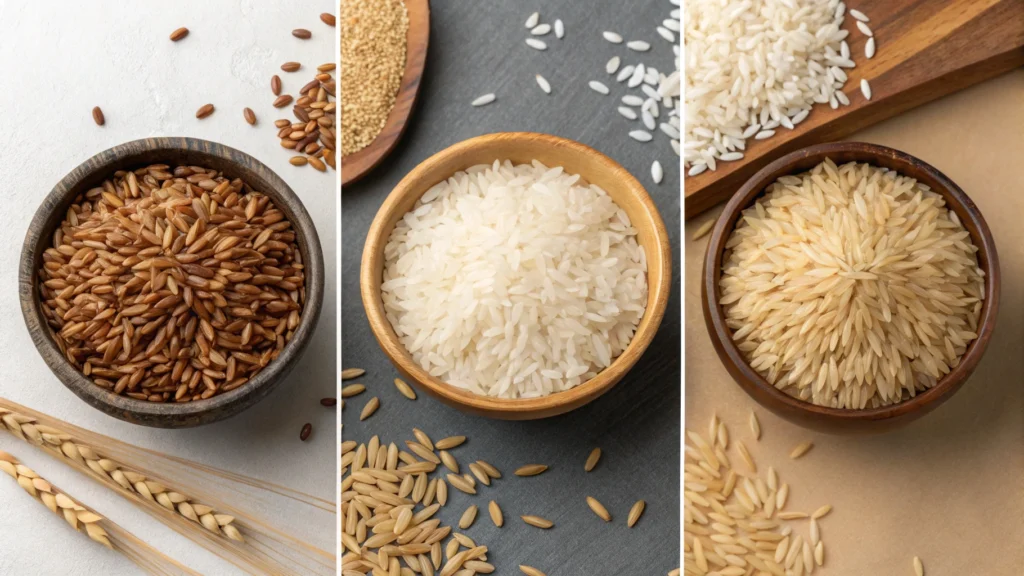
III. Tip #1: The Crucial Rinse: Washing Away the Excess Starch
The first step toward achieving steamed rice perfection lies in the rinsing process. Rinsing rice is a crucial step that’s often overlooked. Therefore, it’s essential for achieving the desired texture.
A. Why Rinse Rice?
Rinsing removes excess starch from the surface of the rice grains. In addition, this prevents the rice from becoming too sticky or clumpy during cooking. By washing away the starch, you ensure that each grain remains distinct and fluffy. As a result, the final product is much more appealing.
B. How to Rinse Rice Properly
To rinse rice, place the desired amount in a bowl. Add cold water. Swirl the rice with your hand until the water becomes cloudy. Drain the water. Repeat this process several times. Therefore, continue rinsing until the water is clear. As an alternative, you can use a fine-mesh sieve. This will ensure that no grains are lost during the rinsing process. Some rice cookers have a rinsing function. This makes the process even easier.
C. The Debate: To Soak or Not to Soak?
Soaking rice is a topic of debate. However, some cooks swear by it. Soaking can help the rice cook more evenly. Also, it can reduce cooking time. In addition, it helps certain rice types, like Basmati, achieve a better texture. The recommended soaking time is usually 30 minutes. However, you can soak for up to an hour.
IV. Tip #2: The Perfect Water Ratio: Achieving Ideal Hydration for Your Rice
Achieving steamed rice perfection depends heavily on the water ratio. Getting the water-to-rice ratio correct is essential for perfect rice. Therefore, the right amount of water ensures that the rice cooks evenly and reaches the desired texture.
A. General Water-to-Rice Ratios by Rice Type
Different rice types require different amounts of water. For example, short-grain rice typically needs a 1:1 ratio of rice to water. Long-grain rice often requires a 1.5:1 ratio. Brown rice usually needs a 2:1 ratio. Refer to a table of reference to verify the exact water ratio.
B. Adjusting for Altitude
Altitude affects cooking time and water evaporation. Therefore, you may need to adjust the water ratio at higher altitudes. At higher altitudes, water boils at a lower temperature. In addition, this can lead to longer cooking times. Increase the amount of water slightly to compensate.
C. Adjusting for Personal Preference
Texture preferences vary. Therefore, don’t be afraid to experiment with the water ratio. If you prefer softer rice, use slightly more water. If you prefer firmer rice, use less. Keep notes of your adjustments. Also, learn from your experiences. This will help you perfect your rice cooking skills.
D. Visual Cues
Visual cues can help you determine if you have the correct amount of water. After adding water, the level should be about one inch above the rice. During the initial cooking phase, the water should be simmering. However, it should not be boiling rapidly.
V. Tip #3: Choosing Your Cooking Method: Stovetop, Rice Cooker, and More
The method you choose can impact the result of your steamed rice perfection. There are several methods for cooking rice. Each has its own advantages and disadvantages. From the stovetop to the Instant Pot, understanding each method can help you achieve the best results.
A. Stovetop Method (Pot)
The stovetop method requires careful attention. Therefore, it offers control over the cooking process. Use a heavy-bottomed pot with a tight-fitting lid. First, bring the water and rice to a boil. Next, reduce the heat to low. Cover and simmer for the recommended time. Avoid lifting the lid during cooking. Troubleshooting common issues includes preventing burning. Sticking can be prevented by using the correct water ratio.
B. Rice Cooker Method
A rice cooker offers convenience and consistent results. Its simplicity and reliability make it a favorite for many. Most rice cookers have settings for different types of rice. This makes it easy to adapt to different varieties. Follow the manufacturer’s instructions for best results. Proper use can prevent overflow and ensure even cooking.
C. Instant Pot Method
The Instant Pot is a versatile appliance for cooking rice. It provides speed and hands-off cooking. Follow the specific instructions for your Instant Pot model. Adjust the cooking time and pressure levels based on the type of rice. Natural pressure release is often recommended for rice. In addition, it helps prevent the rice from becoming too mushy.
D. Microwave Method
The microwave method is a quick option for cooking rice. However, it requires careful attention to prevent overcooking. Use a microwave-safe container. Combine rice and water in the correct ratio. Cook on high for the recommended time. Allow the rice to stand for a few minutes after cooking. This allows the moisture to distribute evenly.
VI. Tip #4: Mastering the Cooking Process: From Simmer to Steam
Mastering the cooking process is crucial for steamed rice perfection. The cooking process involves several stages. Each stage plays a vital role in achieving the desired texture. Understanding these stages will improve your rice cooking skills.
A. The Initial Boil (Stovetop)
The initial boil is the first step on the stovetop. Bring the water and rice to a rolling boil over high heat. This helps to hydrate the rice grains quickly. Therefore, it sets the stage for even cooking.
B. Reducing to a Simmer
Once boiling, reduce the heat to the lowest setting. Cover the pot tightly. Simmer gently for the recommended time. A consistent, low simmer is essential. It prevents the rice from burning or sticking to the bottom of the pot.
C. Avoiding Peeking and Stirring
Avoid lifting the lid during cooking. Peeking releases steam. In addition, it disrupts the cooking process. Also, avoid stirring the rice. Stirring can make the rice mushy. Allow the rice to cook undisturbed.
D. The Steaming Phase
After simmering, remove the pot from the heat. Allow the rice to steam for 10-15 minutes. This allows the remaining moisture to distribute evenly. Consequently, it improves the overall texture of the rice.
E. Cooking Time for each Rice Variety
| Rice Type | Water Ratio | Cooking Time |
| Short-Grain | 1:1 | 15-20 mins |
| Medium-Grain | 1.25:1 | 18-22 mins |
| Long-Grain | 1.5:1 | 20-25 mins |
| Brown Rice | 2:1 | 45-50 mins |
| Wild Rice | 3:1 | 45-60 mins |
| Parboiled Rice | 2:1 | 20-25 mins |
VII. Tip #5: The Fluffing Ritual: Separating the Grains for Perfection
Fluffing the rice after cooking is crucial for steamed rice perfection. Fluffing is an essential step for achieving light and fluffy rice. In addition, it prevents the grains from sticking together.
A. Why Fluff?
Fluffing releases excess moisture from the rice. Therefore, it helps to separate the grains. This results in a more appealing texture. Also, it prevents the rice from becoming clumpy.
B. The Right Tool for the Job
Use a fork or a rice paddle (shamoji) to fluff the rice. These tools are gentle and won’t damage the grains. Avoid using metal utensils. Metal can scratch the pot.
C. The Gentle Touch
Fluff the rice gently. Lift and separate the grains from the bottom up. Avoid pressing down on the rice. A gentle touch will ensure that the grains remain intact.
D. How to Maintain Fluffiness
After fluffing, cover the pot loosely. This will help to retain moisture. Also, it will keep the rice warm. However, it will prevent it from becoming soggy.
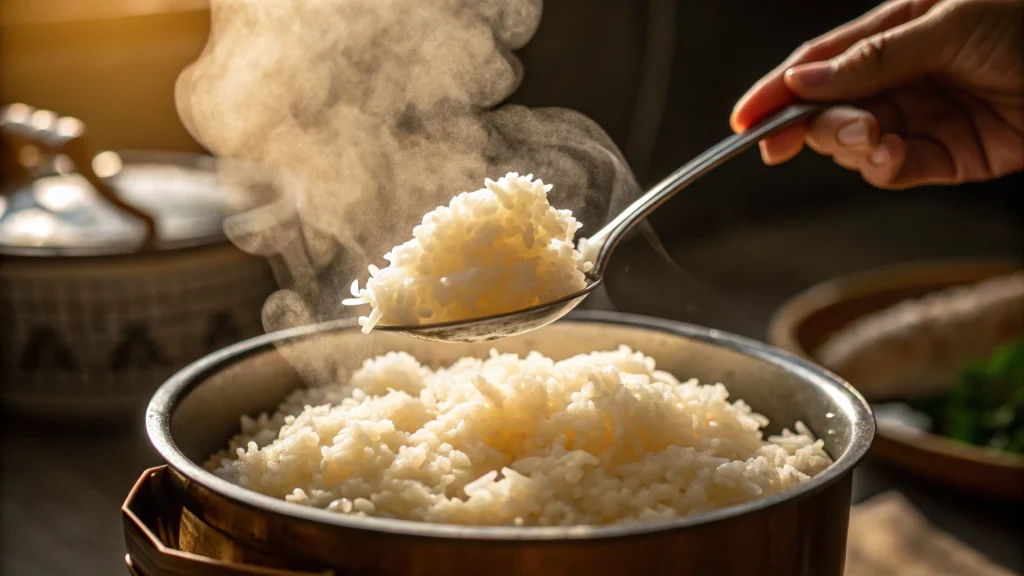
VIII. Tip #6: Seasoning and Enhancing the Flavor
Enhancing the flavor of your steamed rice perfection can transform a simple side dish into a flavorful complement to your meal. There are several ways to enhance the flavor of rice. From simple additions like salt to more complex methods like cooking with broth, the possibilities are endless.
A. Salt: The Basic Enhancement
Salt is a basic but essential addition. It enhances the natural flavor of the rice. Add salt to the cooking water. This ensures that the rice is seasoned evenly. A general recommendation is about 1/2 teaspoon of salt per cup of rice.
B. Cooking with Broth or Stock
Cooking rice in broth or stock instead of water adds depth of flavor. Use chicken broth or vegetable broth for a richer taste. The recommended broth-to-rice ratio is the same as the water-to-rice ratio.
C. Infusing with Aromatics
Add aromatics to the cooking water. Garlic, ginger, and bay leaves are excellent choices. These aromatics infuse the rice with a subtle, yet delicious flavor. Remove the aromatics before serving.
D. Finishing Touches
After cooking, add herbs, spices, or a drizzle of olive oil. Fresh herbs like parsley or cilantro can add a vibrant touch. Spices like turmeric or cumin can create a more complex flavor profile.
E. Additions
Adding butter for richness gives a luxurious mouthfeel. Similarly, adding sesame oil for aroma adds a nutty fragrance. Adding lemon zest for brightness cuts through the richness.
Simple Rice Recipe
This recipe yields fluffy, perfectly cooked rice.
Ingredients:
- 1 cup long-grain rice (such as Basmati or Jasmine)
- 1 1/2 cups water
- 1/2 teaspoon salt
Instructions:
- Rinse the rice: In a bowl, place the rice and cover with cold water. Gently swirl the rice with your hand. Drain the cloudy water. Repeat this process 2-3 times until the water is clearer. Rinsing removes excess starch. Therefore, this helps prevent the rice from becoming sticky.
- Combine ingredients: In a medium-sized pot, add the rinsed rice, water, and salt.
- Bring to a boil: Place the pot over high heat. Bring the mixture to a rolling boil.
- Simmer: Reduce the heat to the lowest setting. Cover the pot tightly with a lid. Simmer for 18-20 minutes. It is important to set a timer. Also, do not lift the lid during this time. This allows the rice to steam properly.
- Steam: After the simmering time, remove the pot from the heat. Leave the lid on. Let the rice steam for 10 minutes. This steaming phase helps to distribute the remaining moisture.
- Fluff and serve: Remove the lid. Use a fork to gently fluff the rice. This separates the grains and releases any remaining steam. Serve immediately.
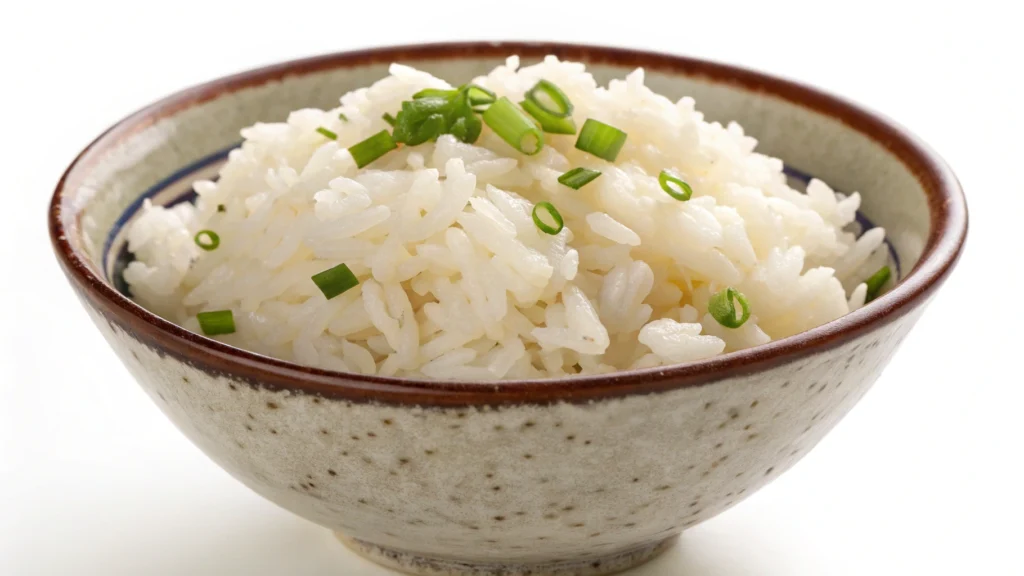
Nutritional Information (per 100g)
| Nutrient | Amount |
| Calories | 130 |
| Protein | 2.7g |
| Fat | 0.3g |
| Carbohydrates | 28g |
| Fiber | 0.4g |
| Sodium | 190mg |
IX. Tip #7: Storing and Reheating Rice Properly
Knowing how to store rice properly ensures steamed rice perfection even after cooking. Proper storage and reheating are crucial for maintaining the quality and safety of cooked rice.
A. Cooling and Storing Cooked Rice
Cool cooked rice quickly. Spread it out on a baking sheet to prevent bacterial growth. Store the cooled rice in airtight containers in the refrigerator. Use within 3-4 days.
B. Reheating Methods
Reheat rice in the microwave, stovetop, or oven. Add a splash of water to prevent drying out. Reheat until it is heated through. Ensure that the rice is steaming hot.
C. Food Safety Considerations
Follow food safety guidelines when storing and reheating rice. This prevents food poisoning. Do not leave cooked rice at room temperature for more than two hours. This is because bacteria can grow rapidly.
X. Troubleshooting Common Rice Cooking Problems
A. Rice is Too Sticky
Causes: Insufficient rinsing, too much water.
Solutions: Gentle fluffing, adding a towel under the lid to absorb excess moisture.
B. Rice is Too Dry
Causes: Not enough water, overcooking.
Solutions: Adding a splash of water and steaming, using a damp towel over the pot.
C. Rice is Burnt at the Bottom
Causes: Too high heat, uneven heat distribution.
Solutions: Lowering the heat, using a heavy-bottomed pot.
D. Rice is Mushy
Causes: Too much water, stirring during cooking.
Solutions: Drain excess water, spread on a baking sheet to dry.
E. Unevenly Cooked Rice
Causes: Uneven heat distribution.
Solutions: Stir the rice partway through the cooking time, adjust the heat source.
XI. Beyond the Basics: Creative Uses for Leftover Rice
Don’t throw away leftover rice! There are many creative ways to use it. Transform it into fried rice, rice pudding, or rice bowls. Leftover rice is a versatile ingredient that can be used in many dishes.
Please find more recipes with leftover rice here : [link to related recipes]
FAQ on Rice Cooking
How to cook rice?
To cook rice, rinse it, combine with water in a pot, bring to a boil, then simmer covered until the water is absorbed and the rice is tender.
How to cook rice the Asian way?
Cooking rice the Asian way typically involves rinsing the rice thoroughly, using a rice cooker or pot, and allowing the rice to steam after cooking for optimal texture.
What’s the water to rice ratio in a rice cooker?
The water to rice ratio in a rice cooker is usually 1:1 for white rice, but you should always consult the rice cooker’s instructions for the best results.
What’s so special about Basmati rice?
Basmati rice is prized for its long, slender grains and aromatic flavor, which makes it ideal for dishes like pilafs and biryanis.
What can I make with Fried Rice?
Fried rice can be customized with proteins like chicken, shrimp, or tofu, and vegetables such as carrots, peas, and onions, all stir-fried with cooked rice and soy sauce.
How to cook rice on stove?
To cook rice on the stove, rinse the rice, combine it with water in a pot, bring it to a boil, then reduce heat to low, cover, and simmer until the water is absorbed.
How does a cook rice machine work?
A cook rice machine, or rice cooker, works by automatically heating the rice and water to a boiling point, then reducing the heat to simmer until the water is absorbed, and finally keeping the rice warm.
Are there any simple rice recipes?
Simple rice recipes include seasoned rice with herbs, garlic rice, or lemon rice, all of which add flavor to plain cooked rice with minimal effort.
Conclusion
Mastering steamed rice perfection is achievable with these 7 expert tips. Therefore, remember to choose the right rice, rinse it properly, and use the correct water ratio. Try different cooking methods. Fluff the rice after cooking. Season it to your liking. Store any leftovers safely. Now, it’s time to experiment and find your own perfect method. What are your own rice-cooking tips? Share them in the comments below!
Cooking is an act of love and creativity! 🌟 What do you think of this recipe? I’d love to hear your thoughts and any tips or tweaks you’d suggest to make it even better. Let’s inspire each other in the kitchen!
There are no reviews yet. Be the first one to write one.


